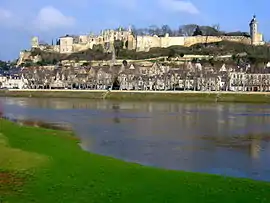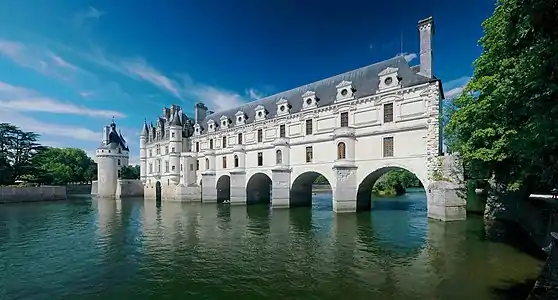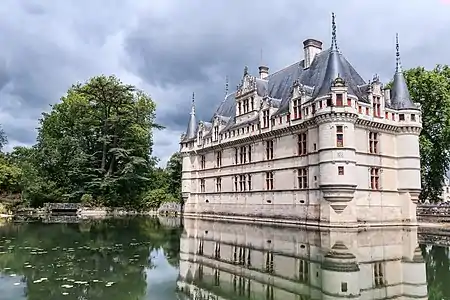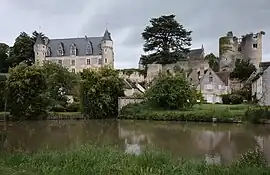Indre-et-Loire | |
|---|---|
 .JPG.webp) _(10439404623).jpg.webp) 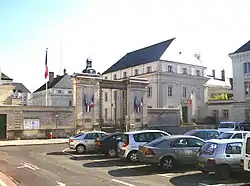  Top down, from left to right: Château de Langeais, Chinon and the Vienne River, Château de Chenonceau and the Cher River, prefecture building in Tours, Château de Villandry | |
 Flag 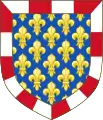 Coat of arms | |
 Location of Indre-et-Loire in France | |
| Coordinates: 47°15′N 0°40′E / 47.250°N 0.667°E | |
| Country | France |
| Region | Centre-Val de Loire |
| Prefecture | Tours |
| Subprefectures | Chinon Loches |
| Government | |
| • President of the Departmental Council | Jean-Gérard Paumier[1] (LR) |
| Area | |
| • Total | 6,127 km2 (2,366 sq mi) |
| Population | |
| • Total | 612,160 |
| • Rank | 41st |
| • Density | 100/km2 (260/sq mi) |
| Time zone | UTC+1 (CET) |
| • Summer (DST) | UTC+2 (CEST) |
| Department number | 37 |
| Arrondissements | 3 |
| Cantons | 19 |
| Communes | 272 |
| ^1 French Land Register data, which exclude estuaries, and lakes, ponds, and glaciers larger than 1 km2 | |
Indre-et-Loire (French pronunciation: [ɛ̃.dʁ‿e.lwaʁ] ⓘ) is a department in west-central France named after the Indre River and Loire River. In 2019, it had a population of 610,079.[3] Sometimes referred to as Touraine, the name of the historic region, it nowadays is part of the Centre-Val de Loire region. Its prefecture is Tours and subprefectures are Chinon and Loches. Indre-et-Loire is a touristic destination for its numerous monuments that are part of the Châteaux of the Loire Valley.
History
Early times
Indre-et-Loire is one of the original 83 departments established during the French Revolution on 4 March 1790. It was created from the former province of Touraine and of small portions of Orléanais, Anjou and Poitou.[4] Its prefecture, Tours, was a centre of learning in the Early Middle Ages, having been a key focus of Christian evangelisation since St Martin became its first bishop around 375. From the mid-15th century, the royal court repaired to the Loire Valley, with Tours as its capital; the confluence of the Loire River and Cher River became a centre of silk manufacturing and other luxury goods, including the wine trade, creating a prosperous bourgeoisie.
Recent years
After the creation of the department it remained politically conservative, as Honoré de Balzac recorded in several of his novels. Conservative Tours refused to welcome the railways which instead were obliged to route their lines by way of Saint-Pierre-des-Corps on the city's eastern edge. The moderate temper of the department's politics remained apparent after the Franco-Prussian War of 1870: sentiments remained predominantly pro-royalist during the early years of the Third Republic. For most of the nineteenth century, Indre-et-Loire was a rural department, but pockets of heavy-duty industrialisation began to appear towards the century's end, accompanied by left-wing politics. 1920 saw the birth of the French Communist Party at the Congress of Tours. By 1920, Saint-Pierre-des-Corps had become a major railway hub and a centre of railway workshops: it had also acquired a reputation as a bastion of working class solidarity.
Geography
Indre-et-Loire is part of the region of Centre-Val de Loire; the neighbouring departments are Loir-et-Cher, Indre, Vienne, Maine-et-Loire and Sarthe. The commune of Descartes is famous as the birthplace of French philosopher and mathematician, René Descartes.
Principal towns
The most populous commune is Tours, the prefecture. As of 2019, there are 10 communes with more than 10,000 inhabitants:[3]
| Commune | Population (2019) |
|---|---|
| Tours | 137,087 |
| Joué-lès-Tours | 38,444 |
| Saint-Cyr-sur-Loire | 16,419 |
| Saint-Pierre-des-Corps | 15,967 |
| Saint-Avertin | 14,995 |
| Amboise | 12,533 |
| Chambray-lès-Tours | 11,880 |
| Montlouis-sur-Loire | 10,868 |
| La Riche | 10,317 |
| Fondettes | 10,301 |
Demographics
|
| ||||||||||||||||||||||||||||||||||||||||||||||||||||||||||||||||||||||||
| Sources:[5][6] | |||||||||||||||||||||||||||||||||||||||||||||||||||||||||||||||||||||||||
Politics
The President of the Departmental Council is Jean-Gérard Paumier of The Republicans.
| Party | seats | |
|---|---|---|
| • | Socialist Party | 18 |
| Miscellaneous Right | 8 | |
| Union for a Popular Movement | 5 | |
| • | Miscellaneous Left | 2 |
| New Centre | 2 | |
| • | French Communist Party | 1 |
Current National Assembly Representatives
Tourism
Indre-et-Loire is home to numerous outstanding châteaux that are open to the public, among them are the following:
- Château d'Amboise
- Château d'Azay-le-Rideau
- Château de la Bourdaisière
- Château de Chenonceau
- Château de Chinon
- Château de la Guerche
- Château de Langeais
- Château de Loches
- Château de Marçay
- Château de Montpoupon
- Château de Plessis-lez-Tours
- Château du Rivau
- Château de Tours
- Château de Villandry
- Château du Clos Lucé
- Château d'Ussé
See also
References
- ↑ "Répertoire national des élus: les conseillers départementaux". data.gouv.fr, Plateforme ouverte des données publiques françaises (in French). 4 May 2022.
- ↑ "Téléchargement du fichier d'ensemble des populations légales en 2021". The National Institute of Statistics and Economic Studies. 28 December 2023.
- 1 2 Populations légales 2019: 37 Indre-et-Loire, INSEE
- ↑ Chisholm, Hugh, ed. (1911). . Encyclopædia Britannica. Vol. 14 (11th ed.). Cambridge University Press. p. 501.
- ↑ "Historique d'Indre-et-Loire". Le SPLAF.
- ↑ "Évolution et structure de la population en 2016". INSEE.
- ↑ Nationale, Assemblée. "Assemblée nationale ~ Les députés, le vote de la loi, le Parlement français". Assemblée nationale.
External links
- (in French) Prefecture website
- (in French) Departmental Council website
- (in English) Indre-et-Loire at Curlie
- (in French) Official tourist website of Touraine Loire Valley

